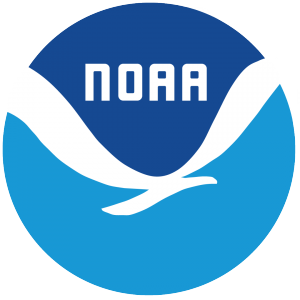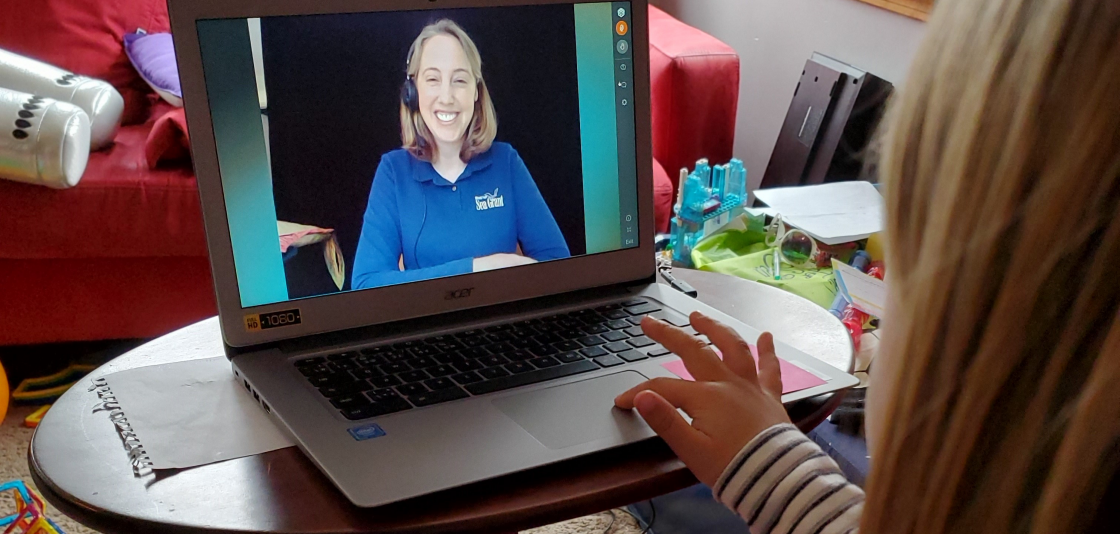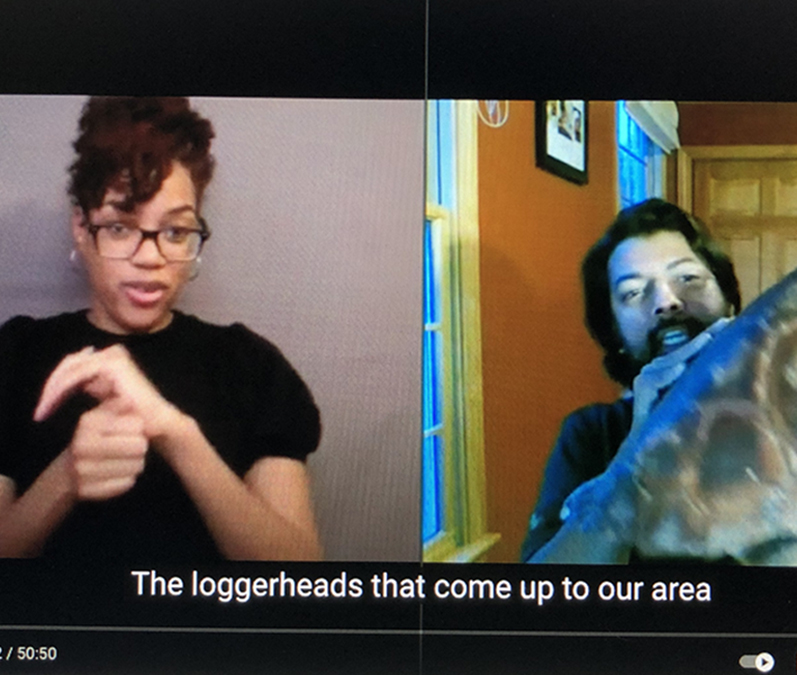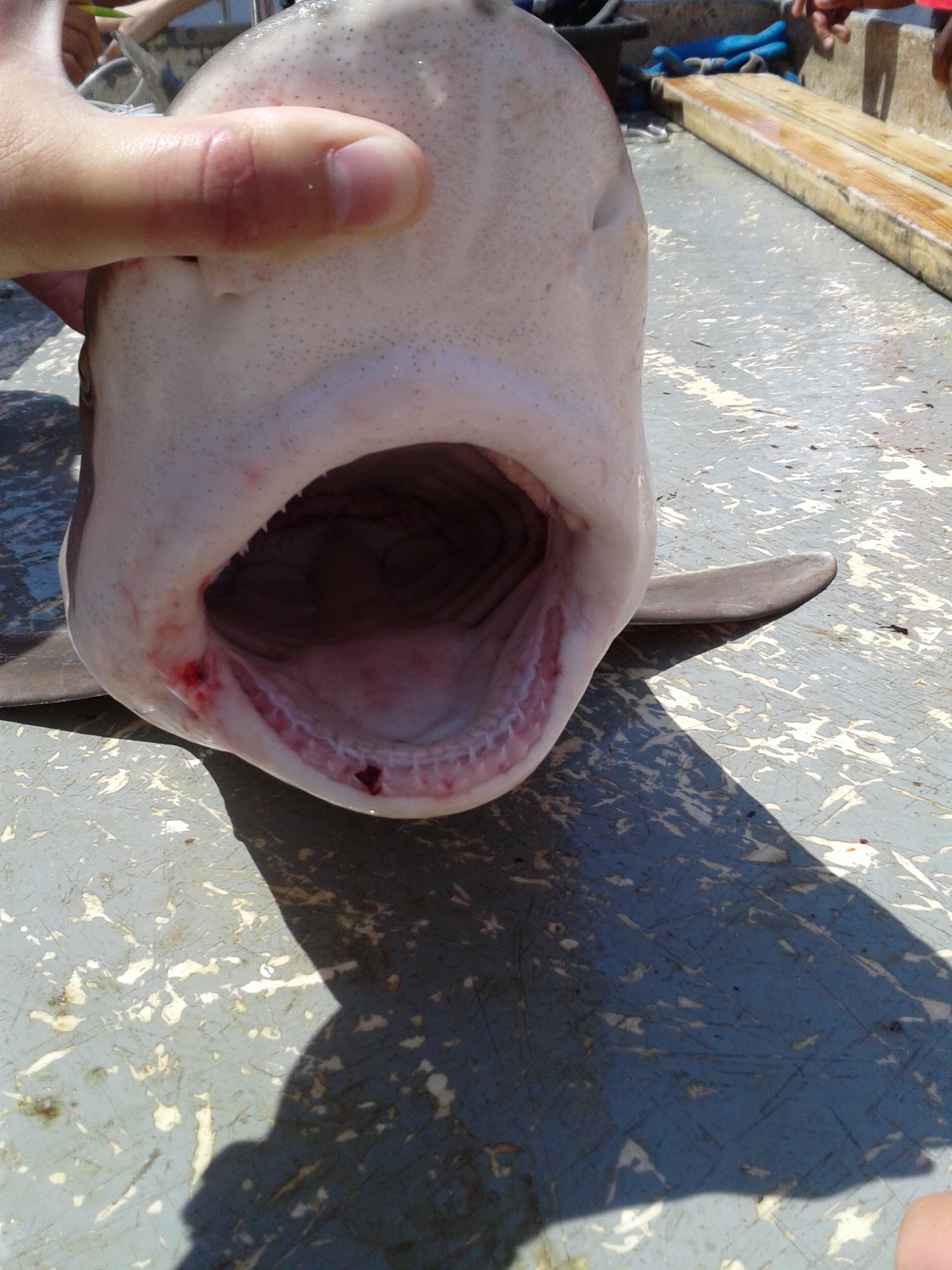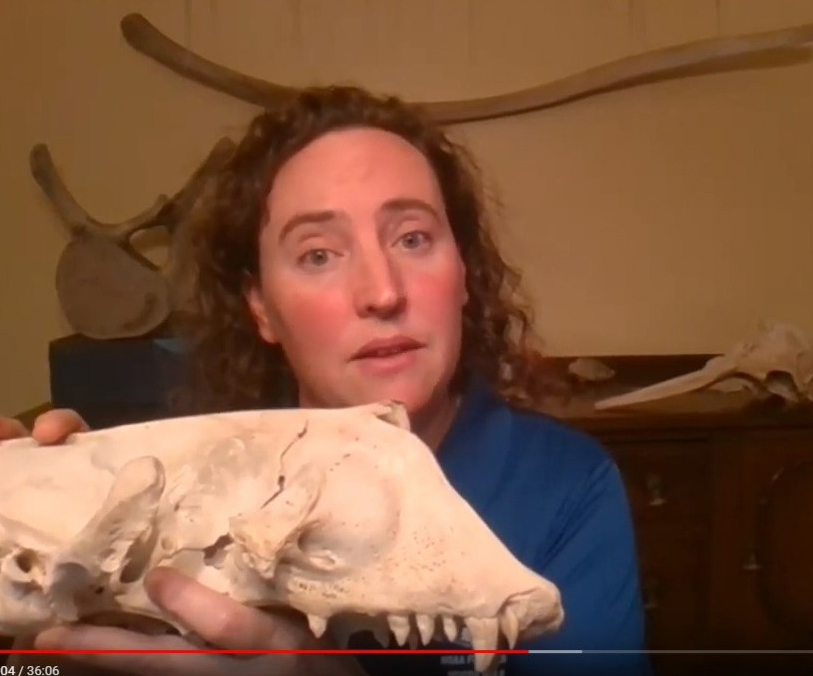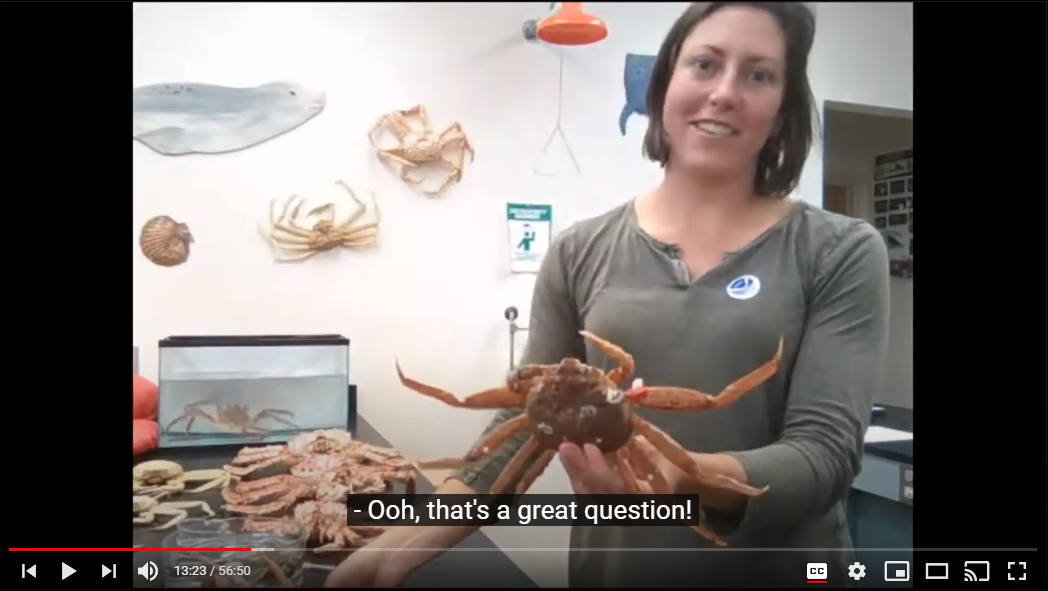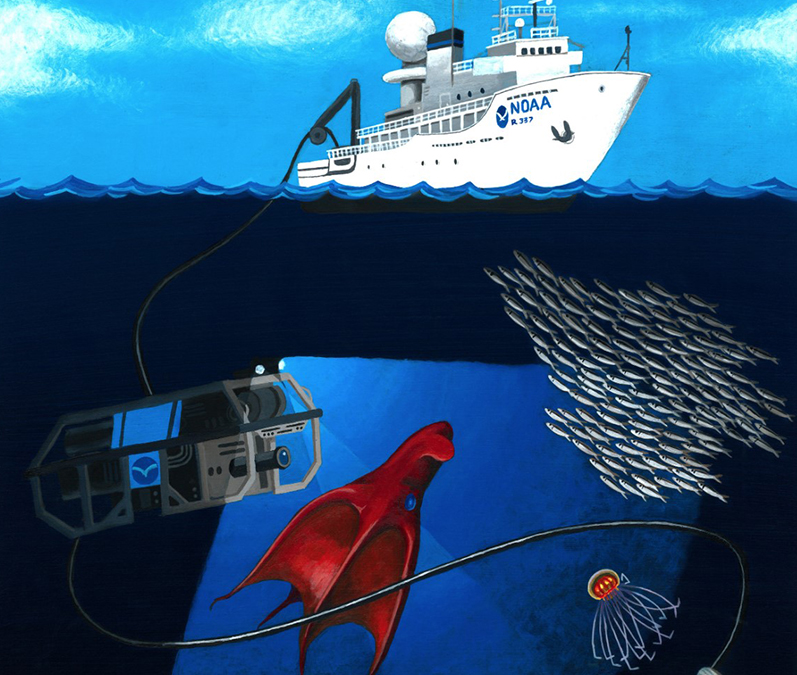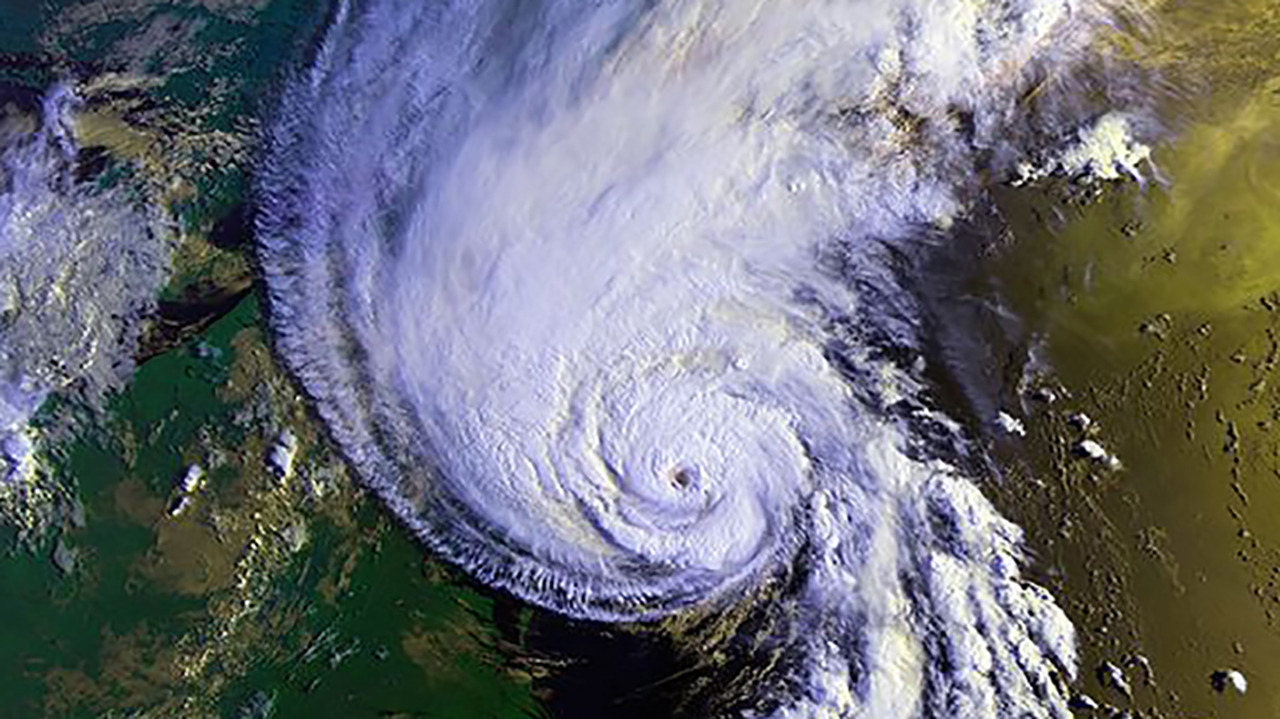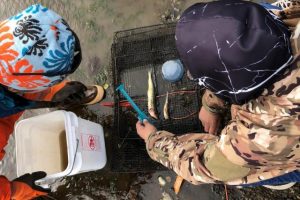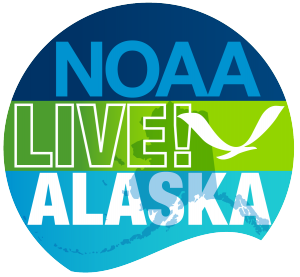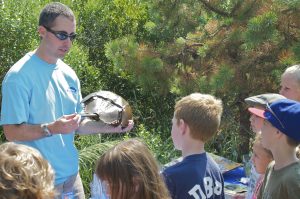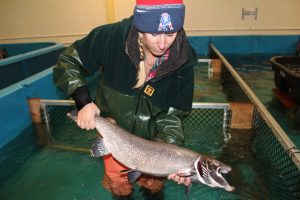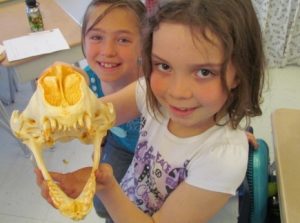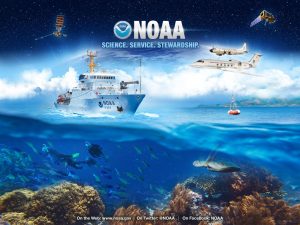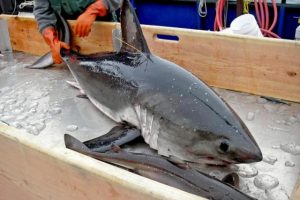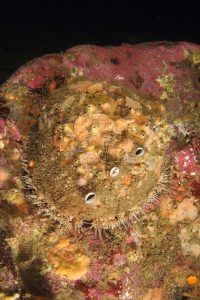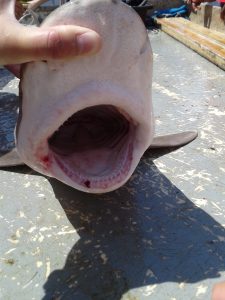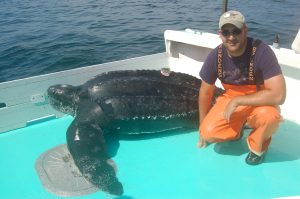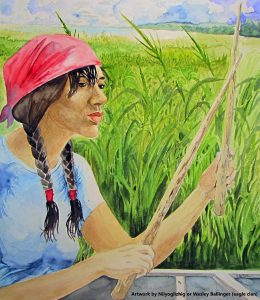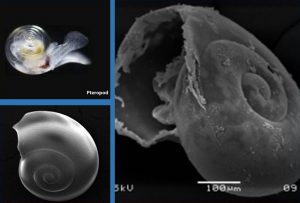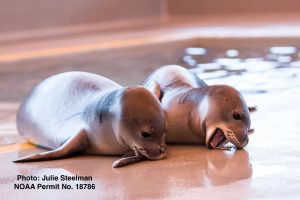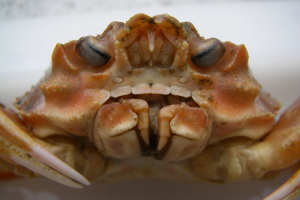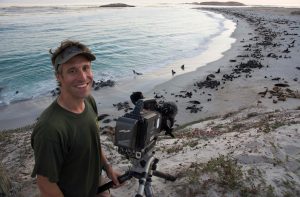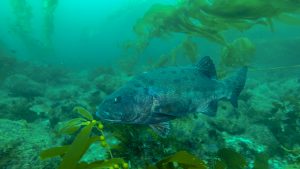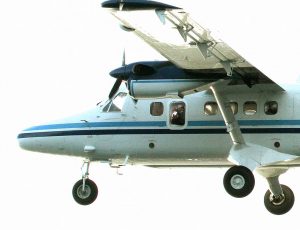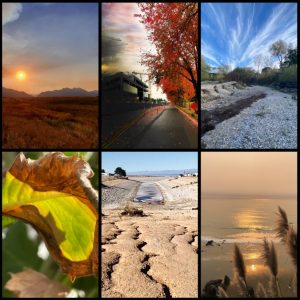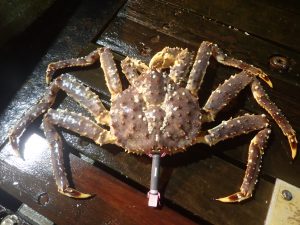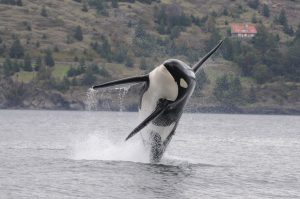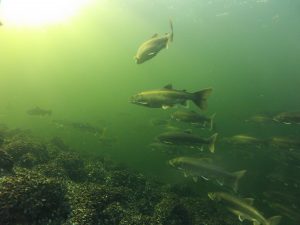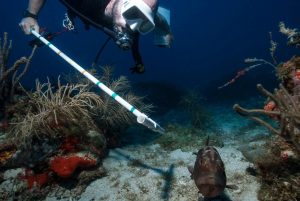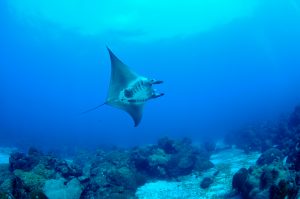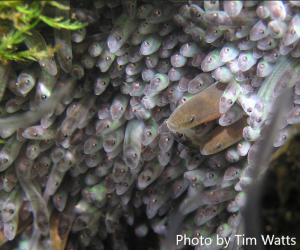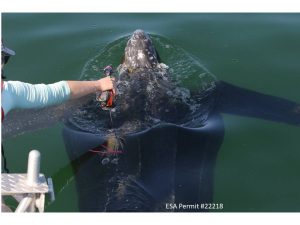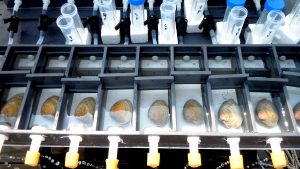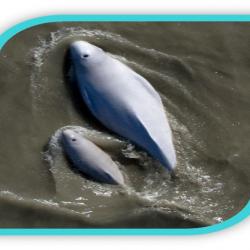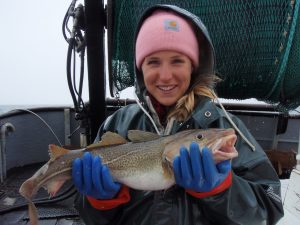Features
• Different NOAA expert and topic with each webinar
• Moderated Q&A webinars with the scientists
• Geared toward Grades 2-8
• Archive of past webinars with English captions and Spanish subtitles
• Why do we make an Indigenous Land Acknowledgment?
• FREE NOAA Live! iron-on patch. Fill out this form to get it in the mail.
• Lesson activities based on NOAA Live!
Sponsors
• National Oceanic and Atmospheric Administration
• National Sea Grant College Program
• NOAA Office of Education
• Woods Hole Sea Grant
• Woods Hole Oceanographic Institution
Find out about other Woods Hole Sea Grant programs on our social media channels!
Upcoming webinars
We do not currently have any upcoming webinars scheduled.
About NOAA Live! webinars
NOAA Live! Webinars were created in response to COVID-19-related school closures. Conducted from March 2020 to present, the webinars are the result of a partnership between NOAA’s Regional Collaboration Network, Woods Hole Sea Grant, and the Woods Hole Oceanographic Institution. These webinars provided students access to scientists, real-life examples of possible career paths, and the opportunity to have fun interacting with others outside their home in a safe way.
Archive
You can search the archive using a keyword or topic filters to the left. NOTE: The NGSS and MA STE standards search function is currently under construction.
Refine by:
Topic
State
NOAA Line Offices
NGSS Topics
MA STE Standards
ASL
Hitching a Ride: How to Spot and Stop Marine Invasive Species
Jasmine Maurer from NOAA’s Kachemak Bay National Estuarine Research Reserve in Kachemak Bay, AK
How do invasive and exotic marine species arrive and spread in Alaska? We will talk about how to monitor and identify European green crab and tunicates, how they affect ecosystems, and what actions to take before the summer season to prevent marine invasive species from impacting your community.
Resources to access at home:
» Community Monitoring – Kachemak Bay National Estuarine Research Reserve
» Invasive Species – Alaska Department of Fish and Game
» Stop Aquatic Hitchhikers!
» Invasive Species – U.S. Fish and Wildlife Service
» Kachemak Bay Environmental Education Alliance – Grab & Go Educational Resources
» Invasive and Exotic Marine Species – NOAA Fisheries
» What is an Invasive Species? – NOAA’s National Ocean Service (video)
Blue Blood, Green Eggs, and Red Knots: The amazing story of the horseshoe crab
Chris Petrone, NOAA’s Delaware Sea Grant in Lewes, DE
About 20 million years ago, the horseshoe crab, as we know it today, evolved. Members of Family Limulidae, which include four extant species of horseshoe crabs, have relatives—the trilobites—that existed on Earth over 500 million years ago! In North America, just one species of horseshoe crabs crawls upon the seafloor eating small clams, crustaceans, worms, and algae. Horseshoe crabs, which are more closely related to scorpions and spiders than true crabs, are incredibly important to the environment and humans. Join us to learn more about this incredible animal and develop your own “Limulus Love.” (Grades 2-6 but all ages will enjoy)
Resources to access at home:
» Delaware Sea Grant’s Horseshoe Crab 15 Second Science YouTube playlist. These short videos are fun, quick, and informative.
» Delaware Sea Grant article: Scientists develop an artificial bait that reduces the need to harvest horseshoe crabs
» The Horseshoe Crab – information about the horseshoe crab.
» The Delaware Bay Horseshoe Crab Survey
» NOAA’s Ocean Today video on horseshoe crabs – “Blue Blood Battles Bacteria”
» Estuaries 101 “Hooray for Horseshoe Crabs” lesson plan
» Horseshoe Crab Origami
» Migrating Shorebirds and Horseshoe Crabs video (~36 seconds long)
» Just flip ’em music video
» Videos Chris shows during his webinar, “egg video” and “feeding video”
» NOAA Ocean Today the Remarkable Horseshoe Crab Videos: There are 5 short videos- The remarkable horseshoe crab, blue blood battles bacteria, and more.
Following ‘Ō‘io: The Life of Hawaiian Bonefishes
Keith Kamikawa, NOAA Fisheries Pacific Islands Regional Office in Honolulu, Hawai’i
It’s easy to follow friends and family who are important to us through social media. But there is no Facebook for fish. So how do we keep track of fish species that are important to our fisheries? Hawai‘i is home to two species of bonefish, including one found nowhere else in the world. Let’s take a look at ‘ō‘io (bonefishes) in Hawai‘i, a favorite catch for local anglers, and follow them throughout their lives. By building their life history “profile,” we can learn how to protect their habitat and fish sustainably so that the next generation can enjoy a future where fishing traditions―and fish―thrive. (Grades 2-6 but all ages will enjoy)
Resources to access at home:
» Habitat Mapping Activity – Color your way through ‘ō’io habitat by hand or on a computer or tablet.
» Pre-spawning aggregation video. (Keith shows a clip in the webinar)
» Bonefish Reproduction Research Project video – You can view a female releasing her eggs.
Fish with Care
» Be a FAST (Fishing Around Seals and Turtles) responder! It’s OK to call for help! If you’re not in Hawai‘i, learn about protected animals in your area and what to do if you see a stranded marine mammal or sea turtle.
» Measure your catch! Check out the Hawai‘i Nearshore Fishes Measuring Guide to figure out which fish to keep or release, or find out about fishing in your area. Download the Fish Rules App for saltwater fishing regulations in Federal and State waters from Maine to Texas.
Get to Know NOAA Habitat Restoration in Your Area
» Fish depend on healthy habitat! Check out the NOAA Habitat Restoration Atlas to find out about restoration projects in your area. The searchable map highlights projects across the nation, including community-based restoration projects.
Leaping for Atlantic salmon: Protecting endangered species
Sarah Bailey, NOAA’s Greater Atlantic Regional Fisheries Office in Orono, ME
Once found as far south as Long Island Sound, today only the state of Maine still has wild runs of endangered Atlantic salmon. In Orono, Maine, NOAA Fisheries has a collection of Researchers, Engineers, and Managers that all work toward saving these fish and the ecosystems that support them. If you have ever wondered about how science helps support how we manage a species-tune in! (Grades 2-6 but all ages will enjoy)
Resources to access at home:
» Northeast Fisheries Science Center: Salmon Team: This is the Northeast Salmon Team website and has important information about the work being done by the group.
» NOAA Species in the Spotlight video on Atlantic salmon.
» Sea-Run, Go! Wild Atlantic salmon app for classrooms and home. After watching Sarah’s webinar you are ready to play! This activity comes with Sea-Run, Go! QR cards that you print out and place around your house! Tape the QR codes up around your house or yard and then have your child play through the app. They go through 11 challenges (QR codes) and get points. They can even compete with their friends (that do the challenges at their own houses).
» U.S. Fish and Wildlife: Teaching kids about fish migration. There is a fun lesson, “Designing fish-friendly culverts (and bridges)” lesson for grades 5-8.
» U.S. Fish and Wildlife: Environmental education resources for teachers, parents, and kids. Activities range from the “ABCs of fishing” coloring book, word searches, migration station, and more.
Marine Mammals in Our Backyard
Grace Simpkins, Woods Hole Sea Grant and Northeast Fisheries Science Center in Woods Hole, MA
Whales are among the largest and oldest animals on earth and belong to a group of marine mammals called cetaceans. Seals are known to be the clowns of the sea and belong to a group of marine mammals called pinnipeds. Interested in learning more about marine mammals? Tune in to find out what makes a mammal a mammal and fun facts about those found around Cape Cod. (Grades 2-6) » View recorded webinar (subtitles available in English and Spanish)
Resources to access at home:
» Southern Ocean seal monitoring: Help monitor populations of seals across the world by tagging time-lapse and drone photographs.
» NOAA Office of Education: This resource collection on marine mammals includes valuable videos, background, activities, and more.
» Science Kids: Plant & Animal Differences Game – This game allows you to sort plants and animals into different categories such as birds, insects, mammals, etc.
» NOAA Fisheries Office of Protected Resources: Whale species information pages.
» Explore.org: watch orcas, manatees, belugas, gray seals, and more (some cameras may only function during a certain season). Explore with dozens of other live cams!
» NOAA Ocean Today: Learn about some of the many species in your local waters and all over the world. Fun and informative 2-minute videos from learning about the North Atlantic right whales to feeding giant octopuses!
» NOAA Ocean Today Endangered Ocean: There are several short videos on topics ranging from the endangered species act, manatees, North Atlantic right whales, and more.
Help from above – using planes, drones, and satellites to study and protect plants and animals **Smithsonian National Air and Space Museum NOAA Family Day**
NOAA Live! All Stars:
Katie Sweeney, NOAA’s Alaska Fisheries Science Center in Seattle, WA
Allison Henry, NOAA’s Northeast Fisheries Science Center in Woods Hole, MA
Brandon Krumwiede, NOAA’s Office for Coastal Management in Duluth, MN
Jennifer Stock, NOAA’s Cordell Bank National Marine Sanctuary in Point Reyes, CA
In partnership with the Smithsonian National Air and Space Museum. This webinar features NOAA experts discussing the ways NOAA aircraft, satellite tracking, and drone technology help us understand marine species and support conservation efforts along our ocean and coasts. How do we use drones to observe northern fur seals, airplanes to identify and count endangered North Atlantic right whales, aerial imagery to manage manoomin (wild rice), and satellite tags to follow seabirds? Learn about the unique tools we use to collect high-quality environmental data to better understand these important species and aid in conservation efforts.
Resources to access at home:
» Soar Together @ Air and Space NOAA Family Day event page: This has links to other live events and fun activities to do with your family
» Arctic UAV’s Game App: Up for a hands-on game challenge? Navigate a flying quadcopter during stormy Alaska weather, catch the perfect aerial shot of rare wildlife, and uncover trails through rough sea ice, all in this mobile app game, Arctic UAVs
» NOAA right whale id matching game- Can you identify the right whales by their callosity? Try it out with these: match the animal cards and answer key
» Seabird and Shorebird Activity Book– The Hawaiian Islands Humpback Whale National Marine Sanctuary put together this fun book. Seabirds secret code, shorebirds word find, seabirds mobile, and more!
» Do a virtual Albatross Bolus dissection– Albatross throw up what they can’t digest. Measure and count natural and non-natural items in this virtual bolus dissection activity.
» Fur seals on Bogoslof Island: Post 4- Evolving Science on an Evolving Island – Katie’s team tested two camera systems on drones on Bogoslof Island in Alaska in September 2019
» New Drone Technology Could Revolutionize Marine Mammal Monitoring
» Association for Unmanned Vehicle Systems International – Student Unmanned Aerial Systems Competition
» Examples of using Unmanned Aerial Systems in NOAA research – NOAA Unmanned Aerial Systems Program
» North Atlantic right whale catalog: The catalog contains all the photographed sightings of right whales from the North Atlantic.
» Stellwagen Bank National Marine Sanctuary Shearwater Tagging Project
» Efforts to Restore Native Wild Rice in the St. Louis River Estuary
» Makani: The albatross that cares for the land: An interactive activity/story book about a Laysan Albatross (pdf download)
» Telepresence technology uses a high-bandwidth satellite connection to allow anyone with an Internet connection to virtually participate in ocean research and exploration expeditions. Join one here and learn more about telepresence here.
Videos
- PBS Wisconsin Education video: This ~4-minute video follows Fred Ackley Jr. from the Sokaogon Chippewa Community of Mole Lake as he harvests and processes manoomin, or wild rice.
- Mapping the Invisible: Introduction to Spectral Remote Sensing: NEON Science video overview of spectral imagery and its use to identify differences between different parts of the electromagnetic spectrum
- Investigating Steller Sea Lion Populations: Join scientists on a research vessel to western Aleutian Islands—closer to Russia than mainland Alaska. Here, they investigate what’s going on with endangered Steller sea lions, some populations of which are declining, while others are thriving
- Henry Wood Elliott: Defender of the Fur Seal: In the twenty years following the United States’ acquisition of the Alaska territory (1867), revenues from the Pribilof Island fur seal harvest paid off the 7.2 million dollar purchase price. This documentary uncovers this little-known piece of American history told through the story of Henry Wood Elliot
- Northern Fur Seal Migrations: Every year, northern fur seals migrate 6,000 miles round-trip from their summer breeding grounds on the Pribilof Islands in the Bering Sea. Learn about the scientists at NOAA who are tracking these seals on their incredible migrations, and where the seals go during the winter
- B-Roll: Northern Fur Seal Research on Bogoslof Island: Select footage of northern fur seal research on Bogoslof Island, an active volcano that erupted from December 2016 – August 2017. This footage was taken August 12-16, 2019, along with some reference match frames that were filmed on July 12, 2005
- NOAA Ocean Today Endangered Ocean: There are several short videos on topics ranging from the endangered species act, manatees, North Atlantic right whales, and more.
- Watch A Perfect Day for an Albatross and Other Seabird Tales, a book reading of Caren Loebel-Fried’s childrens book with special highlights shared from her trip to the Albatross breeding colony on Midway Atoll National Wildlife Refuge and seabird highlights from the Papahanaumokuakea Marine National Monument, a UNESCO World Heritage Site and Cordell Bank National Marine Sanctuary.
- “This is NOAA” video (~3 min): This video describes NOAA’s role as a global leader in environmental science and technology, working to address our Nation’s most pressing challenges and advance our mission of science, service, and stewardship
Previous NOAA Live! Webinars by these experts
- A Bird’s Eye View of Whales with Allison Henry
- Flying Beneath the Clouds at the Edge of the World with Katie Sweeney
- Winged Ambassadors: Ocean Travelers with Jennifer Stock
- Drones, Scat, and the Joys of Marine Mammal Fieldwork in Alaska with Katie Sweeney
- Fresh Coast: Where Food Grows on the Water with Brandon Krumwiede
North to the Future: Alaskan sharks in a changing ocean
Cindy Tribuzio, NOAA Fisheries Alaska Fisheries Science Center in Juneau, AK, and Sabrina Garcia, Alaska Department of Fish and Game in Anchorage, AK
Scientists at the Alaska Fisheries Science Center conduct research and assess the stocks of many species of sharks in Alaskan waters. Join us for a discussion of the different sharks found in Alaskan waters, some fantastic research partnerships and how we use research to conserve and manage the species into the future.
Resources to access at home:
» NOAA Fisheries – Fish and Sharks webpage
» Fun Facts about Shocking Sharks
» Shark Research in Alaska: NOAA Fisheries
» Alaska Department of Fish and Game – The Undersea World of Salmon and Sharks (@ADFGUnderseaWorldOfSalmonAndSharks): Facebook page with exciting scientific research on Alaskan salmon, sharks, and their ecosystems and ecology!
» Salmon Shark Tagging in the Bering Sea: Alaska Fish & Wildlife News
» Gills Club: STEM-based education initiative dedicated to connecting girls with female scientists around the world to inspire shark and ocean conservation
Abalone: Gardeners of the Kelp Forest
David Witting, NOAA’s Restoration Center in Long Beach, CA
We will learn more about abalone, a group of large snails that live in kelp forest habitats around the world. These humble snails “garden” the kelp forest and ensure there is space for the other plants and animals living there. For thousands of years, people living on the California Coast have harvested this beautiful animal and we will explore how they were used for food, tools, jewelry, and cultural ceremonies. We will end by looking at the status of abalone today, with 2 species on the endangered species list and the others in such low numbers they can no longer be fished. We will learn how NOAA and its dedicated partners are teaming up to save this important animal.
Resources to access at home:
» Aquarium of the Pacific kids song/video: “I Love Abalone”
» NOAA Fisheries Feature Story: “Divers Release Endangered Abalone into the Wild for First Time, Boosting Odds of Recovery ”
» NOAA Fisheries Feature Story: “White Abalone: Why You Should Care About This Critter”
» NOAA white abalone “Species in the Spotlight” video
Sharks Make Sense
Chris Flight, NOAA’s Mississippi-Alabama Sea Grant Consortium at the Dauphin Island Sea Lab in Dauphin Island, AL
Sharks are some of the most successful predators in the ocean. There are hundreds of different species that come in all sorts of shapes and sizes. Have you ever wondered what makes them so good at what they do? We will examine several different species of sharks, talk about the variety of senses that sharks use to find their food, and get up close and personal with the jaws of one of the most common sharks swimming around Mobile Bay Alabama. (Grades 2-6 but all ages will enjoy)
Resources to access at home:
» OCEARCH Tracker Page – This map of tagged sharks shows you real-time, up to date locations on a variety of tagged sharks
» Dauphin Island Sea Lab archived Facebook Live Events– These videos cover a variety of topics. Some examples are, stingrays, alligators, crustaceans, lionfish, and many more!
» Atlantic White Shark Conservancy – This site lists all of the AWSC shark enrichment programs during school closures.
» Shark vocabulary that Chris used during his webinar.
» NOAA story: 12 Shark Facts that May Surprise You
Turning Up the Heat: Fish and sea turtles in a warming world
Vincent Saba, NOAA’s Northeast Fisheries Science Center in Woods Hole, MA and NOAA’s Geophysical Fluid Dynamics Laboratory at Princeton University in Princeton, NJ
From microscopic plants to large whales, climate change is affecting all ocean life. There are many ways in which climate change can affect ocean ecosystems but during this webinar, we will investigate the effects of warming temperatures on marine fish and sea turtles. Marine fish spend all of their life in the water but did you know that sea turtles must lay their eggs on beaches? We’ll explore how our warming planet affects fish and sea turtles in very different ways.
Resources to access at home:
» NOAA Fisheries article: Climate Change in the Northeast U.S. Shelf Ecosystem
» Overview of how climate change affects sea turtles
» Project marine species range shifts by selecting the species, time frame, and variable such as temperature, salinity, etc. (This is for more advanced students and adults)
» NASA climate kids -the climate time machine: See into the past and look ahead to the future of amounts of sea ice, the sea level, carbon dioxide, and global temperature
» NASA climate kids – a kids guide to climate change including how the changing climate affects the ocean
Fresh Coasts: Where Food Grows Wild on the Water
Jennifer Ballinger, Brandon Krumwiede and Heather Stirratt, NOAA’s Office for Coastal Management in Chanhassen, MN
Wild rice or manoomin is a Great Lakes aquatic plant that makes our coasts special. Wild rice is a keystone species, both for the ecosystems of the Great Lakes and the people who call this place home. Join NOAA’s Office of Coastal Management as we talk about how we help restore and protect the coastal wetlands where wild rice grows, the importance of wild rice to Great Lakes tribal nations, airborne data collection, and career paths to working with wild rice and Great Lakes.
Resources to access at home:
» NOAA article: Spotlight on People and Pollution: Wild rice, pollution, and space for traditions to grow
» NOAA article: Sea Grant and partners work together to restore culturally important wild rice
» NOAA article: Restoring and Monitoring Lake Superior Coastal Wetland Manoomin
» NOAA 1-minute video on coastal management (it was used in the webinar)
» PBS Wisconsin Education video: This ~4-minute video follows Fred Ackley Jr. from the Sokaogon Chippewa Community of Mole Lake as he harvests and processes manoomin, or wild rice.
It’s Not Easy Being Shelled: The Ocean Acidification Blues
Meg Chadsey, NOAA’s Washington Sea Grant and the NOAA Pacific Marine Environmental Lab in Seattle, WA
Excess carbon dioxide (CO2) isn’t just warming the planet; it’s also reacting with seawater and making the oceans more corrosive—a process known as ocean acidification. This slight increase in acidity doesn’t change the way the ocean looks or feels to us—but it’s a big deal for marine species with hard parts made of calcium carbonate, like pteropods, whose delicate shells begin to dissolve when exposed to acidified seawater. Meg Chadsey will demonstrate how ocean acidification is stressing her favorite local shellfish species—oysters—and explain why some shellfish farmers are turning to kelp for help.
Resources to access at home:
» Lego Calcification Challenge Activity
» Red Cabbage Ocean Acidification in a Cup Activity
» Rosemary Mosco’s Ocean Acidification Cartoon: pretty much everything you need to know about OA in 8 panels
» What is Ocean Acidification: A Crash Course – a 2-minute animated video, drawn by Sherman’s Lagoon cartoonist Jim Toomey
» Washington Sea Grant Ocean Acidification webpage
» The Power of Kelp: a 6-minute video about the benefits of kelp farming
» Washington Sea Grant’s Kelp Aquaculture webpage: a deep dive into the many uses for farmed kelp
» Tracking Ocean Acidification in Puerto Rico Video: this 8-minute video is in Spanish with an English subtitle option
» Ocean Acidification and Clownfish: This is a ~5-minute video
It Takes a Village to Save the Hawaiian Monk Seal
Stacie Robinson, NOAA Fisheries Pacific Islands Fisheries Science Center in Honolulu, HI and Wendy Marks, the Marine Mammal Center in Kona, HI
Did you know that Hawaiʻi is home to the world’s only tropical seal – the Hawaiian monk seal? You’ll learn about these highly endangered marine mammals, where they live, and the conservation efforts to protect them. We’ll follow monk seals on an underwater foraging adventure using cameras worn by the seals! You can see the methods the seals use to explore their environment and search for food. We will also highlight the partnership between NOAA and The Marine Mammal Centerʻs Ke Kai Ola Hospital. Located in Kona, on Hawaiʻiʻs Big Island, Ke Kai Ola is a place where sick and injured Hawaiian monk seals are brought for treatment and rehabilitation. We will be sharing some seal patient stories and how we help seals both in the hospital and out on the beaches.
Resources to access at home:
» Marine animal stranding network: You can find your region and the number to call if you see a marine animal.
» NOAAʻs Hawaiian Monk Seal Coloring Book
» NOAA Fisheries Hawaiian Monk Seal Species Page
» The Marine Mammal Center – Online Learning Resources
» Aloha ʻĀina Activity about littering and marine debris
» Mālama i nā ʻĪlioholoikauaua about sustainability
» Marine Mammal Monday: Saving Species recording and activity
» Some Ocean Optimism Ep. 6: Hawaiian Monk Seals, 6-minute video
The crab-tivating life of crustaceans: diving into Alaskan snow crab and red king crab biology
Erin Fedewa and Leah Zacher, NOAA Fisheries Alaska Fisheries Science Center’s Kodiak Laboratory in Kodiak, AK
Join us as we learn about red king crab and snow crab, two species of crab found in Alaskan waters. Guest appearances from live crab at the Kodiak Fisheries Research Center and a virtual dissection will help us explore crab biology and life stages. This webinar will be recorded and posted here (with English captions) after going live. (Grades 2-8 but all ages will enjoy)
https://seagrant.whoi.edu/wp-admin/post-new.php?post_type=noaa_live_webinar
Resources to access at home:
» Red king crab life stages – a short course
» Crab education pages
» NOAA Fisheries – Red King Crab
» NOAA Fisheries – Snow Crab
» New Studies Raise Questions About Crabs’ Adaptability
» Dutch Harbor Snow and Tanner Crab Growth Study – a science blog
Demystifying Science through Video
Filmmaker Paul Hillman, NOAA Fisheries Communications Office in Seattle, WA
Science can be a tough nut to crack for a lot of people, and sometimes getting the information straight from a scientist can be full of technical jargon and difficult to understand. But science is the backbone for many of the decisions and policies that we make at NOAA, and we want to effectively communicate this science to you. To do this, we have a team of filmmakers that create videos that illustrate our science in educational and entertaining ways. Tune in to learn more about how to make science films, and to learn about a career in science when you’re actually an artist! The webinar will last about 45-60 minutes with moderated questions and answers throughout. This webinar will be recorded and posted afterward. (Grades 6-8, but all ages will enjoy) » View recorded webinar (subtitles available in Spanish and English)
Resources to access at home:
» NOAA Fisheries Video Gallery Watch some of these amazing videos on topics ranging from aquaculture, coral conservation, sustainable fisheries, and more.
» NOAA Fisheries YouTube Channel. View a wide variety of videos on topics ranging from protected species, species in the spotlight, and more.
Giant Seabass, Kings of the Kelp Forest
Ryan Freedman, NOAA’s Channel Islands National Marine Sanctuary in Santa Barbara, CA
Giant Seabass are a species of large fish that live in the cool waters off the coast of California. Thanks to government protections in California, this top predator of the kelp forest is beginning to return to the Channel Islands National Marine Sanctuary and NOAA is working with other groups to study them. Giant Seabass are unique because scientists believe they use sounds to communicate. NOAA is working to record these sounds in the wild and study how these fish move around Santa Barbara Island, a small offshore island in the sanctuary. (Grades 2-6 but all ages will enjoy)
Resources to access at home:
» “Return of the King” – An article on how researchers track giant sea bass populations in the Channel Islands National Marine Sanctuary
» Channel Island National Marine Sanctuary education page. This includes an encyclopedia of sanctuaries, marine reserves interactive map, and more.
» Map of the Channel Islands National Marine Sanctuary.
A Bird’s Eye View of Whales
Allison Henry, NOAA’s Northeast Fisheries Science Center in Woods Hole, MA
Whales are among the largest and oldest animals on earth and belong to a group of marine mammals called cetaceans. Talk to a member of NOAA’s North Atlantic right whale aerial survey team and learn how they do science from the sky. (Grades 2-6)
Resources to access at home:
» Picture Matching- Right Whales: COAST Program activity used in our lesson to match North Atlantic right whale drawings to the real right whale picture. Answer key
» North Atlantic right whale catalog: The catalog contains all the photographed sitings of right whales from the North Atlantic.
» Right Whale Listening Network: Learn about North Atlantic Right Whales and how acoustic buoys can help prevent ship strikes.
» Northeast Regional Office- North Atlantic right whale lesson: Discover the world of the North Atlantic right whale through lessons and activities on the biology, ecology, and conservation of this endangered species (Grades 6-8).
» NOAA Right Whale Sighting Advisory System – Interactive map of North Atlantic right whale sightings.
» National Geographic- Blue Whale Migration Activity: This activity allows you to map blue whale migration and develop stories to explain their behavior.
» NOAA Ocean Today Endangered Ocean: There are several short videos on topics ranging from the endangered species act, manatees, North Atlantic right whales, and more.
Picture Climate Change: A glimpse at climate change in the west through the lens of American youth
NOAA West Regional Team
The NOAA West Regional Team will showcase the winners of NOAA’s “Picture Climate Change” Student Photo Contest during this NOAA Live! 4 Kids Event!
NOAA challenged students in fifth through twelfth grade from all U.S. states and territories to help NOAA understand how climate change has impacted them, their family, their school, and their community. The goal? To show this impact of climate change through a photo. NOAA asked students, “In what ways has your landscape, wildlife, or way of life changed due to climate shifts?” And students delivered.
The photos NOAA received from students tell tales of drought, flood, fire, pollution, extreme heat or cold, and smoke. The student summaries shared stories of evacuating during a wildfire, of worry for species and their habitats, and how hard it is to breathe when fires degrade air. The photo contest left NOAA in awe of the student images that were submitted, each one radiating the students’ fear, concern, and outrage of climate change impacts — and also, the students’ hope and desire to combat climate change.
Join this NOAA Live! 4 Kids event to experience what students shared with NOAA about their climate change perspectives. You’ll hear from NOAA experts about the cutting-edge science, research, and projects happening now that relate to the climate impacts students shared with NOAA through their photos.
Resources to access at home:
» Talking to Children about Climate Change article on the NOAA National Ocean Service Planet Stewards page
» NOAA Planet Stewards archive: This includes webinar presentations by scientists, educators, and communicators to the NOAA Planet Stewards’ community. There is valuable content about climate change, becoming a citizen scientist, teaching climate change, and much more!
» Discover Your Changing World with NOAA: Full activity book that you can download or individual activities
» NASA climate kids -the climate time machine: See into the past and look ahead to the future of amounts of sea ice, the sea level, carbon dioxide, and global temperature
» NASA climate kids: a kids guide to climate change including how the changing climate affects the ocean
» The Incredible Carbon Journey: Play the Carbon Journey Game with your class or a group at home (Use the blue “Jump to this Activity” button on the website linked to here).
» NASA Climate Kids Offset Game: As you play this online game you earn money so you can buy “upgrades” to your carbon sources and sinks. Meanwhile, carbon dioxide molecules are escaping into the atmosphere.
The Crab-tivating Life of Crustaceans: Where do they go? How do they grow? What do we know?
Erin Fedewa and Leah Zacher, NOAA Fisheries Alaska Fisheries Science Center’s Kodiak Laboratory in Kodiak, AK
How much do you know about Alaskan crab? Join us as we learn to identify crustaceans found in Alaskan waters and talk about crab biology with live appearances from some “crabby” guests. We’ll even find out how to tag a red king crab and explore how researchers use these tags to study where crab live and how they move!
Resources to access at home:
» A Sneak Peek inside the Kodiak Lab Aquarium
» NOAA Live! Alaska Webinar 80: A Dive into Daily Life at the Alaska Fisheries Science Center’s Kodiak Lab
» NOAA Live! Alaska Webinar 43: The Crab-tivating Life of Crustaceans: diving into Alaskan snow crab and red king crab biology
» Red king crab life stages – a short course
» Crab education pages
» New Studies Raise Questions About Crabs’ Adaptability
» Dutch Harbor Snow and Tanner Crab Growth Study – a science blog
» NOAA Fisheries Species Pages:
Killer Whale Tales: Environmental Science through Storytelling
Lynne Barre, NOAA Fisheries West Coast Regional Office and Jeff Hogan, Killer Whale Tales in Seattle, WA
How can you help recover endangered orcas? Join Lynne Barre, NOAA’s Recovery Coordinator for endangered killer whales, and Jeff Hogan, Executive Director of Killer Whale Tales, to learn about the Southern Resident population of killer whales, the challenges they face, and what you can do to be a steward for the whales and help conserve their habitat.
» Download the datasheet used during the webinar
Resources to access at home:
» Saving the Southern Resident Killer Whales NOAA website: This includes an introduction to southern resident orcas, threats they face such as contaminants, vessel noise, and prey availability, and the work being done on recovery of the species
» Killer Whale Tales Activity Guide and Orca Research Sheets: This has a word search, turn your family tree into a pod, fun facts, behavioral datasheets, and more.
» NOAA Fisheries Orca Outreach and Education Materials: This website includes a fin matching activity, be whale wise poster, and how to take action.
Lessons from Lake Trout in Lake Champlain
Ashley Eaton and Caroline Blake, NOAA’s Lake Champlain Sea Grant in Burlington, VT
Lake Champlain, known as Bitawbakw by the Abenaki people, is home to lake trout. As one of the top predators in Lake Champlain, they play an important role in maintaining balance within the lake ecosystem. When lake trout populations struggled, it took coordinated efforts to contain sea lamprey to help them recover. Management of sea lamprey has greatly reduced stress of lake trout and since 2015 lake trout populations have been slowly recovering. Join us to learn the heroic tale of the Lake Champlain lake trout, and the efforts that inform conservation of this important freshwater species!
Resources to access at home:
» Nebi: Abenaki Ways of Knowing Water | Lake Champlain Sea Grant: This video is mentioned in the webinar (~10 minute long)
» Zoom a Scientist: A fish’s story: following lake trout movement around Lake Champlain (~50 minute long webinar)
» Fish Files – Lake Trout (~3 minute long video)
» Fish Files – Lake Trout Dissection (video)
» Fashion a Fish: This activity is aimed at students K-5
Fin-tastic Fun with Coral Reef Fish Surveys in South Florida and the Caribbean
Erin Cain and Jay Grove, NOAA’s Southeast Fisheries Science Center in Key Biscayne, FL
Take a dive with us into coral reef fish communities and learn all about how we identify, survey, and help inform managers about reef fish populations through NOAA’s National Coral Reef Monitoring Program (NCRMP). Using engaging, interactive photos and videos, we will help hone your investigative skills to identify fish parts and learn that appearances aren’t just skin deep. If all goes swimmingly, you should learn about the importance of counting fish, the coral reef ecosystem, and your role in their future.
Resources to access at home:
» The Coral Reef Conservation Program’s efforts to increase fisheries sustainability
» NOAA’s Interactive Reef: As you run your mouse over this image, species will light up and you can click on them to open a feature page with an image and information.
» NOAA’s Activity Book on coral reefs: This activity booklet is aimed at grades 3-5.
» NOAA’s Fishwatch.gov: Get the most up-to-date info on popular seafood harvested or farmed in the US to help you made educated seafood choices.
» NOAA’s National Coral Reef Monitoring Program Status Reports: Referenced in the webinar, you can find the most recent status report on the coral reefs at Flower Garden Banks, Florida, Puerto Rico, U.S. Virgin Islands, and Pacific locations.
» What you can do to help coral reefs?
Texas Corals, and Mantas, and Sharks, Oh My!
Kelly Drinnen, NOAA’s Flower Garden Banks National Marine Sanctuary in Galveston, TX
Did you know that there are coral reefs off the coast of Texas? These amazing reefs are part of Flower Garden Banks National Marine Sanctuary in the Gulf of Mexico. Join us to learn more about these reefs and the wonderful sea creatures that live there. From tiny corals and shrimp, to sponges, fish, sea turtles, manta rays, and whale sharks, you’ll discover why coral reefs are home to 25 percent of all ocean life.
Resources to access at home:
» Flower Garden Banks National Marine Sanctuary: For Teachers – Curriculum, lessons, activities, and posters
» Flower Garden Banks National Marine Sanctuary: For Kids – Did You Know?, word puzzles, activities, holiday fun
» Flower Garden Banks National Marine Sanctuary: Coral Basics
» Dive in and find the National Marine Sanctuary closest to you
» Flower Garden Banks National Marine Sanctuary Coral Reef Word Search used in the webinar.
» Relevant NOAA Live! Webinars: “Dive In and Explore Coral Reef Ecosystems”
» Flower Garden Banks National Marine Sanctuary species list
» Flower Garden Banks National Marine Sanctuary videos of reef creatures
» Stories from the Blue: Lt. Dustin Picard: This 4-minute video features diving in Flower Garden Banks National Marine Sanctuary
Dambusters at Work: Restoring Habitat for Migratory Fish
Eric Hutchins, NOAA Restoration Center in Gloucester, MA
Soon after the Pilgrims landed at Plymouth Rock they began to build dams on Town Brook in Plymouth, Massachusetts. Every dam built impacted the migratory pathway of American eel and river herring which need to reach fresh water streams to complete their lifecycle. This talk will describe efforts by the Town of Plymouth and NOAA to remove or modify dams on Town Brook to restore habitats for migratory fish….and wait until you hear what they found when they tore down those dams!
Resources to access at home:
» Meet Eric Hutchins, Habitat Restoration Biologist Feature Story
» U.S. Fish and Wildlife: Teaching kids about fish migration. There is a fun lesson, “Designing fish-friendly culverts (and bridges)” lesson for grades 5-8.
» U.S. Fish and Wildlife: Environmental education resources for teachers, parents, and kids. Activities range from the “ABCs of fishing” coloring book, word searches, migration station, and more.
» NOAA Fisheries article, “You can help scientists count migrating river herring – virtually”
» U.S. Fish and Wildlife: Teaching kids about fish migration. There is a fun lesson, “Designing fish-friendly culverts (and bridges)” lesson for grades 5-8.
» U.S. Fish and Wildlife: Environmental education resources for teachers, parents, and kids. Activities range from the “ABCs of fishing” coloring book, word searches, migration station, and more.
» Help count the river herring:
–Mystic River, Massachusetts Herring Counter, https://www.mysticherring.org/video#/
–Town Brook, Plymouth Massachusetts Herring Counter https://www.plymouthriverherring.org/
» Watch Live Fish Cameras:
–Herring Creek on Martha’s Vineyard https://wampanoagtribe-nsn.gov/naturalresourcedepartment
–Town Brook, Plymouth Massachusetts Herring Counter https://www.plymouthriverherring.org/
» Other relevant NOAA Live! Webinars: Swimming Upstream with River Herring OR Leaping for Atlantic Salmon: Protecting endangered species
Seeing the World Through a Sea Turtle’s Eyes
Samir Patel, NOAA Fisheries Northeast Fisheries Science Center in Woods Hole, MA
Sea turtles are considered living dinosaurs in that they have remained relatively unchanged for over 100 million years and yet continue to thrive in our world’s ocean. How are turtles able to do this? We use several camera techniques to film sea turtles as they swim through the ocean diving, foraging, and avoiding predators to understand how they are able to survive and thrive in their preferred habitats.
Resources to access at home:
» Sea turtle stranding network: You can find your region and the number to call if you see a stranded sea turtle.
» NOAA Education sea turtle page: Find information about the six species of sea turtles found in U.S. waters, stories, background material, videos, and classroom lesson plans and activities.
» Sea Turtle identification guide for the Northeast US
» National Marine Life Center in MA: Their virtual discovery zone has a sea turtle puppet craft, live patient updates on their sea turtles currently in rehab, and many videos.
» NOAA’s Activity Book on sea turtles: This activity booklet is aimed at grades 3-5.
Science on the Half Shell: Behind the Scenes at the Milford Fisheries Laboratory
Mark Dixon and Gillian Phillips, NOAA Northeast Fisheries Science Center in Milford, CT
Have you ever wondered what kind of science is conducted at a fisheries laboratory? Meet NOAA scientists from the Northeast Fisheries Science Center’s Laboratory in Milford, CT, who study shellfish and investigate questions that help shellfish growers around the world. You will learn about what oysters eat, how they are helping make a cleaner Long Island Sound, and see, through real fish surveillance, how shellfish farms can become habitat for other species.
Resources to access at home:
» Current research at Milford
» Fish printing is usually a popular station: Read this article on the educational uses of gyotaku or fish printing. Try it at home after watching this video (for older kids) or this video (for younger kids). Remember – you can use a rubber fish and even print onto clothing.
Baby Beluga in the Shallow Gray Sea – looking for newborn whales with drones in Cook Inlet, Alaska
Kim Goetz, NOAA Alaska Fisheries Science Center in Seattle, WA
Learn about the endangered population of Cook Inlet beluga whales which regularly swim past local Anchorage landmarks such as the Port, Kincaid Park, the airport, and Bird Point in Turnagain Arm. We will talk about how belugas live, see cool photos of them taken from a drone that we use to recognize newborn baby whales, and listen to them buzz and chomp on a fish! This webinar will be recorded and posted here (with English captions) after going live. (Grades 2-8 but all ages will enjoy)
Resources to access at home:
» Studying Endangered Cook Inlet Belugas in Alaska
» Beluga Whale Hexacopter Survey – Science Blog
» Belugas Count! video
» Species in the Spotlight: Cook Inlet Beluga Whale
» Plumbing the Deep: Using Sound Waves to See
Fishing for Food and Facts
Anna Mercer, NOAA’s Northeast Fisheries Science Center in Narragansett, RI
Did you know that U.S. fisheries produce over 9 billion pounds of seafood every year? Join this webinar to learn how NOAA Fisheries works with fishermen to produce sustainable seafood that feeds people all over the world. In this webinar, you will learn about the species that are harvested in the northeast U.S., how they are caught, and how NOAA Fisheries helps fishermen develop tools to fish more effectively and collect data for science. (Grades 2-6 but all ages will enjoy)
Resources to access at home:
» U.S. Seafood Facts at Fish Watch
» Fisheries of the United States
» NOAA Fisheries Cooperative Research
» National Marie Sanctuaries Fish and Fishery Facts in California. This has some great information on where fishing occurs, the different fisheries, fishing vessel types, fishing gear, seafood markets, and more.
» Seafood Nutrition Partnership Website. NOAA Fisheries is a partner and you can find seafood 101, the science of seafood, and more.
What’s in that Mouthful of Seawater: Introducing the Ocean’s Microscopic World
Vera Trainer, NOAA’s Northwest Fisheries Science Center in Seattle, WA
The ocean’s microscopic single-celled organisms produce over half the world’s oxygen. These phytoplankton provide clean air, draw down carbon dioxide responsible for climate change, and are a major source of food for marine creatures. However, some phytoplankton can produce chemicals that are poisonous to humans, marine mammals, and birds. These harmful algal blooms are responsible for shutting down shellfish harvest and causing fish kills around the world. This talk will provide an introduction to the beauty and danger of the microscopic marine world. (Grades 2-6 but all ages will enjoy)
Resources to access at home:
» NOAA Northwest Fisheries Science Center’s video, “Science at Sea – The Hunt for Killer Algae.” (20 minutes long)
» Why Do Fish Get Sick? youtube video
» Tabs on Habs Videos– These are an introduction to Harmful Algal Blooms and their Identification. There is a beginner, intermediate, and advanced series of videos.
» The National Ocean Service’s Harmful Algal Blooms (HABs) website. There is regional information so you can look up HABs in your area, resources such as how we forecast HABs, frequently asked questions, and more!
» Nature Video’s “Five Reasons to Thank Plankton” that Vera showed during her webinar. Find out how much you owe these little guys.
» WHOI website on harmful algae blooms. This resource has maps, species, impacts, and more.
» Download the “Phyto” app for free on your smartphone. You can access a series of flashcards with both freshwater and marine phytoplankton. Learn to identify phytoplankton and their proper pronunciation.

